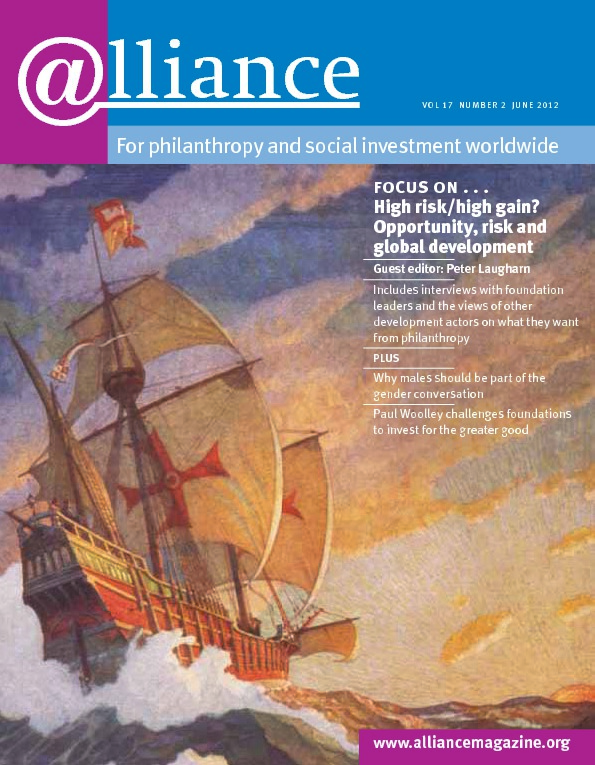Most of us have been brought up to believe that free markets combined with healthy competition deliver good outcomes. We also presume that what holds true in goods markets also applies in financial markets. The reality has made a mockery of this belief. Capital markets have come to resemble less the embodiment of efficiency, more a war zone. If foundations adopted investment policies more in line with this reality, they could secure better long-term returns on their own investments. At the same time, as large institutional investors, they could play a significant role in shaping the future of long-term investing and helping to bring stability to financial markets.
The standard paradigm for how financial markets work comes from the work of a group of Chicago economists who formalized the ‘efficient markets hypothesis’ in the 1970s. According to this theory, competition means prices are always ‘right’, capital markets are self-stabilizing, and no one can consistently earn excessive profits.
Everything we have observed in recent years has been the antithesis of the world described by this theory. Equity returns have been wretchedly low and volatile; bubbles, crashes and crises abound; and the return on fixed income has collapsed with no early prospect of improvement. Bankers have alternately made billions in profits and bonuses or come cap in hand to be rescued with bail-outs of even greater magnitude.
Because there has been no accepted alternative to the received wisdom, most of the policy actions and decisions of asset owners such as pension funds and charitable foundations are still based on the presumption of market efficiency. Sadly, new research shows that investing on the basis of a misunderstanding of how finance works leads to low and volatile returns and leaves asset owners vulnerable to exploitation by intermediaries.
The flaw in the efficient markets hypothesis is its failure to recognize that the bulk of asset owners (call them the principals) do not invest directly but delegate the task to agents, such as fund managers, banks and brokers. Delegation creates problems because agents have better information and different objectives from the principals, and the principals have difficulty learning whether agents are competent and diligent. In the case of foundations, the trustees are responsible for fulfilling the mission of the foundation while investment of assets is usually delegated to professional investment managers.
A new theory of finance
Five years ago my colleagues and I at the London School of Economics, the University of Toulouse and UTS in Sydney set about rewriting asset pricing theory by acknowledging the principal/agent problems that plague finance. We show the two fundamental consequences of this. First, stocks, bonds, sectors, even entire asset classes can become seriously mispriced in an apparently competitive market even though all market participants are acting rationally in their individual self-interest. Second, agents are able to extract in fees and expenses a large chunk of the returns rightfully belonging to their clients’ capital.
Mispricing can be traced to the simple fact that asset owners hire and fire fund managers on the basis of recent performance. Underperforming managers are assumed to be incompetent and replaced by those who have been lately successful. This process contributes to the amplification of price shocks: in effect, the overshooting of fair value (based on a security’s future dividend stream) that creates momentum (trending) and subsequent reversal in prices. Think of what happened when value managers were being replaced by growth managers as the Tech bubble inflated in 1999-2000.
Once mispricing gets into the system, investors are tempted to ride the trends instead of investing on the basis of underlying worth. The new theory shows that asset prices respond to the short-term fund flows moving across markets. The efficient market hypothesis denies the importance of such flows, believing instead that prices depend solely on the expected future earnings from each asset.
The capture of excess profits, or ‘rents’, by agents is a separate and insidious consequence of delegation. Buying a washing machine, you can judge its quality based on the reputation of the maker and the look, feel and action of the product; and you can take it back if it fails. In fund management you cannot tell whether the product you commit to buying is any good until it is too late. The asset owner, ie the foundation, bears all the risk, whereas the agent receives his fees and bears no risk.
For 25 years a wide range of empirical work has been revealing the various distortions and inefficiencies displayed by financial markets, but with no theory to explain them. The new body of theory we are developing does a good job of explaining features of market performance hitherto unexplained or unaddressed, including momentum and reversal, value and growth, under- and over-reaction, and short-termism.
Remedies for asset owners
Being able to explain where the finance sector is going wrong also points to the remedies. We show that the act of delegation to agents lies at the heart of mispricing and rent capture. If asset owners can be made aware of the situation and learn how to mitigate the worst of the problems, they can gain a significant private benefit in the form of higher risk-adjusted returns. Foundations are under fewer constraints to follow the herd than pension funds, which are more subject to regulatory and actuarial supervision, so they are more likely to be early movers. Once a significant body of giant funds follows suit, social advantages will follow in the form of a more stable and less exploitative financial sector.
Here are the main actions that big funds can take:
1 Adopt a long-term approach to investing based mainly on long-term dividend flows rather than momentum-based strategies that rely on short-term price changes.
The entire edifice of the fund management industry is built on two mutually inconsistent strategies: ‘fair value investing’, based on a security’s future dividend stream, and ‘momentum investing’, which means riding the latest trend. Both can be effective if executed well and there is merit in combining them for diversification. For investors with early liabilities and therefore ultra-short horizons, the quick pay-off of momentum makes it the strategy of choice.
For those with longer horizons, like most foundations, fair value investing is the better choice for three reasons. First, success with momentum is sensitive to timing, not buying too early nor selling too late. By comparison, value strategies are less sensitive and can work using quite basic techniques. Second, momentum investors are always buying after prices have started to rise and selling after they have started to fall. Collectively, therefore, momentum investors lose out to fair value investors. Third, when a momentum bet fails the investor moves on to the next stock. Momentum is thus a succession of independent bets, making its long-run risk equal to the sum of the short-run risks. If a fair value investment fails in the short run, it is likely that the stock has got cheaper and will be retained. For the fair value investor, long-run risk therefore declines over time as the ups and downs tend to even out.
2 Cap annual turnover of portfolios at 30 per cent per annum.
Asset owners can set guidelines that either explicitly limit momentum or give the delegated managers less cause to use it. Momentum is used by hedge funds to gain quick short-term gains and long-only managers use it to reduce short-term divergence against peer group or benchmark. Momentum is a high turnover strategy whereas fair value investing requires patience and has much lower turnover. It follows that the easiest way to ensure compliance is to limit turnover to around 30 per cent per annum.
3 Adopt stable benchmarks for fund performance.
Using stock and bond indices as benchmarks is tying your fund’s performance to a relic of the efficient markets hypothesis. The ideal benchmark is one that follows a relatively stable path over time, reflects the characteristics of the liabilities, and is grounded in real cash flows. Foundations seek a stable, and hopefully steadily growing, real income over time. They have less concern about short-term fluctuations in market values than pension funds, which are obliged to provide annual appraisals of their current financial situation. Annual growth in GDP, whether national or global, represents the ideal benchmark for overall performance.
4 Understand that all the tools currently used to reduce risk and diversify are based on the discredited efficient markets hypothesis.
Investors should base their risk and diversification decisions on the underlying cash flows of securities and asset classes, not on market prices. Market values are subject to big swings and give misleading signals, whereas dividend streams are more stable. Efforts by long-horizon investors to reduce short-term price volatility against a mispriced index come at the expense of long-term returns. Moreover, once a new asset class becomes popular, all the price correlations change and the hoped-for diversification gains mostly disappear.
5 Be wary of any form of ‘alternative investing’
Over recent years it has been increasingly fashionable for pension and other funds to invest in alternative asset classes – hedge funds, commodities and private equity. Advisers point to the advantages of diversification and the greater opportunities open to the supposedly more talented management these asset classes attract.
It is not surprising that these innovations have enriched the managers rather than their clients. Principal/agent problems are greatest in new and complex financial products. High leverage and performance-related fee structures encourage risk-taking and therefore moral hazard. Agents can hide behind the opacity and lower reporting standards. Recent evidence shows that 85 per cent of the returns on all the capital ever invested through hedge funds has disappeared in fees.
By pursuing strategies based on the defunct efficient markets hypothesis, foundation trustees are both damaging their own funds and contributing to the wider destruction of social utility. Each foundation that adopts these policies will benefit, whether or not other funds follow suit. As more and more funds adopt them, the social gains will come through more stable financial markets. Foundations that recognize the problems set out here and begin to act along the lines suggested will thus be aligning their own incentives with those of society at large.
Paul Woolley is a Senior Fellow of the Paul Woolley Centre for the Study of Capital Market Dysfunctionality at the London School of Economics. Email p.k.woolley@lse.ac.uk
 Comment: John Howchin
Comment: John Howchin
When Mistra turned its attention to investment, it was focused mainly on its own investments and how to find managers that could align its investment strategy with Mistra’s aim as a foundation. Mistra aims to support research of strategic importance for solving major environmental problems and contributing to the development of a sustainable society. Assets under management were SEK 2.7 billion at the end of 2011.
This resulted in Mistra being the first institutional investor in Generation Asset Management and starting the Sustainable Investment Research Platform (SIRP) research programme over six years ago. Mistra has now aligned its whole portfolio along sustainable investment criteria.
The behavioural aspects of market participants has been a substantial focus of the SIRP programme from its initiation, and expectations in this area continues to evolve, as Paul Woolley clearly outlines in his excellent article. As market participants, we cannot focus solely on what we invest in, in terms of equity and bonds; we also need to focus more on who we are as market participants and what expectations we have of the markets as a whole. We keep taking the financial markets for granted, allocating ever-increasing amounts of capital to them and expecting good returns, maybe without giving the system itself the oversight and stewardship it needs in order to deliver sustainable returns.
I agree with Woolley’s wider point that foundations and other large institutional investors should start to look not only at their investment strategies but also at their expectations of the market participants they fund through their strategies. As for Mistra, which uses only external managers, this has resulted in a much more thorough process to find managers. What we look for are asset managers that have a sustainability-based, ESG (environmental, social and governance) strategy with a low portfolio turnover and finally, but not least, are actively engaged with the companies they invest in – with the aim of improving the sustainability strategy of the company.
Mistra performs an annual review of the asset managers and their active strategies. In this process we have also started to look at how managers are remunerated. We intend to continue our engagement within this area, both funding research and also as a responsible investor with the long-term aim of creating a more sustainable marketplace.
John Howchin is a member of Mistra’s asset management committee and an SIRP board member. Email Howchin@spray.se
 Comment: James Brooke Turner
Comment: James Brooke Turner
There’s nothing worse than an ex-smoker, people say, because they become such articulate and powerful critics of that habit. But what about an ex-fund manager such as Paul Woolley, lately of GMO Woolley (now just GMO)? The same is probably true, at least in terms of his deep and extensive knowledge of investment management.
As he explains in his article, the theoretical basis of how to invest is based on a particular academic theory which emerged in the 1950s, and which is now so pervasive it is difficult to see its tentacles. For example, pensions are invested, and then valued, based on this model. Those who understand and interpret the model for us are in a powerful position, and the fees are high. In turn this leads to social inequality and so forth. So it’s very important that this theory is right. But Woolley’s credible suggestion is that it’s not. It’s wrong, and it’s wrong because it fails to reflect the self-interest of the agents who do the interpreting for their clients.
There is a wonderful quote in Richard Jenkins’ new report on endowment finance and governance (see p7) to the effect that trustees put in place an investment policy to do the best for the long term, ‘then you see managers chasing annual benchmarks which they chose in the first place’. This represents a strange interpretation of prudence. Long-term owners of assets should bear in mind that generally they make money from inactivity, while advisers make money from activity.
Woolley suggests a series of steps that investors can take to get back in the driving seat of their own assets, all of which are sensible, understandable and practical. Trustees would be well advised to study these principles and then put them into practice. Foundation endowments should be the natural hotbed of exploring new thinking such as this since they have a broader agenda than other fiduciaries, such as pension funds, to advance society’s wellbeing. But trustees are often too timid to reach out for a new paradigm without support from a specialist advisory community, and there’s the rub: which part of the advisory community is going to set out to persuade trustees that complex, expensive advice may be not only unnecessary but possibly counter-productive?
Perhaps we should all pause before we find another investment solution and take time to really engage with our purpose. After all, we are asked to look out for others more vulnerable than us, and the money we have is for them, not us. What is in their best interests?
James Brooke Turner is finance director of the Nuffield Foundation. Email jbrooketurner@nuffieldfoundation.org
 Comment: Andre Betting
Comment: Andre Betting
Paul Woolley is, in my opinion, right in his analysis of some crucial characteristics of the capital markets and investors in those markets. The age-old principal/agent problem is distorting the alignment of interests. The fact that many investment managers have large parts of their personal wealth co-invested in the funds they manage reduces the problem somewhat, sometimes, but does not remove it.
Short-termism plays an important role. It takes strong convictions to swim against the short-term tide. Trustees of foundations have been taught to be rational and detached when making investment decisions, and strong convictions cannot always be rationally argued. Worse, trustees might find it disturbing when a colleague has very strong investment convictions that go against the general trend.
So what about an alternative model? I feel that Woolley is catching a trend in the world of endowed foundations. Although ‘total return’ investing (where the changes in the value of assets are part of the return that can be spent) is still the norm, I see a clear trend towards old-fashioned ‘income’ investing (when only the cash income generated by assets can be spent). Just as significant, I see a trend towards more ‘direct’ investments, where a foundation owns assets directly without an intermediary. These assets can be marketable stocks or bonds, but they can also be ‘alternative’ assets.
Combine these two trends, and I conclude that Woolley’s first recommendation is slowly being adopted, and his fifth and last recommendation is being adopted as well (not by eliminating, but by directly managing ‘alternative’ investments). His recommendation regarding capping annual turnover in portfolios is worth a try, but probably needs a shift to direct investing, because the universe of external managers willing to cap at 30 per cent is limited.
I also agree with his recommendation to adopt alternative benchmarks. The only benchmark that ultimately counts is the ‘fiduciary benchmark’: do we live up to our fiduciary responsibility? Often this responsibility includes maintaining purchasing power after spending. This is simple and understandable. All other benchmarks are complex, confusing and often misleading. But it is tempting to get lost in endless discussions on the correct benchmark!
Finally, Woolley recommends moving away from focusing on fluctuating fair market valuations and modelling. This is a logical sequence to his other recommendations. But this move would go against a lot of efforts over recent years. Fair market values are now widely used to model investment decisions and performance. They serve as a tool for transparency and objectivity. Stepping back from this trend might be exactly the bold move based on strong convictions that I referred to earlier. But it also shows how difficult that is in practice. And yes, foundations can be trendsetters here. In their own interest, and in the wider interest of investors generally.
Andre Betting is executive director of the Van Leer Group Foundation. Email andre.betting@vanleergroupfoundation.nl
Co mment: Jeffrey Heil
mment: Jeffrey Heil
I agree with Paul Woolley’s primary tenet of a fundamental disconnect between agents (investment managers) and principals (asset owners). This disconnect stems from the asset owners’ delegation to investment managers and gives rise to two serious issues: managers’ capture of excess profits from investment returns, and asset owners’ inability to accurately measure manager performance in generating these returns.
Woolley’s remedies for asset owners consist of five action points. Three of these I agree with as they are already so widely accepted that they are almost clichés: adopting a long-term view, maintaining lower turnover, and using a stable benchmark.
On the two remaining points, I do have some disagreement. I would assert first, based on my interactions with fellow endowment and foundation CIOs, that almost nobody mentions efficient markets or the Capital Asset Pricing Model (CAPM) any more. In fact, institutional use of active managers across all asset classes is proof of their disbelief in efficient markets.
Woolley’s last point is that investors should ‘be wary of any form of alternative investing’. I wholeheartedly endorse this, not because of the underlying assets but rather because of the fee structure that the managers typically employ. Avoiding alternative assets as a class would diminish returns by shrinking the opportunity set, forcing investors to depend only on lending (fixed income) and global economic growth (equities) for returns. Investors would have to give up the liquidity premium and ignore successful private companies by only trading via exchanges.
On the other hand, overpaying fees is, in my view, the single biggest issue that asset owners need to deal with today. This bleeding of investor returns can be dealt with via a simple but profound change in performance fee structure: use of a rolling three-year average, hopefully with a related benchmark. This would remove the asymmetry in the incentive fee structure whereby managers participate in the upside but not in the downside (they can earn $1 billion for their investors and $300 million for themselves in one year, and then lose that $1 billion of investor funds two years later, with no consequences to themselves).
Finally, Woolley’s point that institutional investors could play a significant role in helping to bring stability to financial markets if a critical mass of them adopted his recommendations seems at best naive. Removing the ‘herd instinct’ of investors could reduce the momentum effect in market swings, but that sort of defies human nature. More important, market risk is really just business risk transferred to enterprise funders and it is precisely for this risk that investors are being compensated.
Jeffrey Heil is chief investment officer of the Doris Duke Charitable Foundation. Email jheil@ddcf.org
 Comment: Laurence Siegel
Comment: Laurence Siegel
Paul Woolley is an accomplished and worldly investment manager whose work with Grantham, Mayo, van Otterloo is highly respected in the foundation world. So it’s surprising to find him suggesting so many bad ideas.
In particular, I’m thinking of his opposition to alternative investments. In fact many of the worst abuses of the last decade have been in traditional stocks and bonds. The track record of AAA-rated tranches of subprime mortgage pools is a case in point: many of them lost 70 per cent or more.
Many companies are finding that going public has lost some of its appeal, and are staying private as long as they can. For example, as Facebook prepares to go public it is reputed to be offered at the gargantuan market capitalization of $100 billion, meaning that most or perhaps all of its high-growth period was accessible only to private equity investors. The appeal of private equity is not just in technology. Natural resource deals and the most promising alternative energy opportunities tend to be in the private equity asset class, especially in emerging markets.
Woolley’s suggestions on benchmarking are some of his most peculiar. A benchmark consisting of the growth rate of GDP is one that nobody can invest in, so it’s impossible to index to it, or to calculate a meaningful alpha or beta for any actual portfolio. Traditional benchmarking is needed so that the investor can find out whether he or she would have done better with an index fund, which is often the case.
Woolley’s critiques of standard finance theory don’t hold much water either. It is not exactly news that the market isn’t efficient and that many or most assets are mispriced. The efficient market hypothesis isn’t an accurate description of reality but a starting point for analysis. While some academics may have believed in its absolute truth at one time, such faith is (and should be) rare today. Moreover, there is a rich heritage of scholarly research that deals with principals and agents, and that suggests how to manage the natural tension between them. Woolley should consult the Nobel Prize-winning writings of Ronald Coase.
Some of Woolley’s ideas aren’t bad but they’re motherhood and apple pie: nobody is really against them. Investing for the long run is one of these. Value or, to use his term, ‘fair-value’ investing is another, although less universally agreed upon.
In closing, Woolley seems surprised that markets go down as well as up, and sometimes stay down for long periods. He doesn’t exactly say it, but he writes as though he believes that markets would steadily rise at satisfactory rates if everyone were honest and the incentives of principals and agents perfectly aligned.
But that is not how markets work. All statistical or market risk is ultimately caused by business risk. The hope of extraordinary gain is what makes people start enterprises, but they usually fail. When you aggregate, the business risk of these individual enterprises does not completely disappear: a considerable amount of it remains in the form of systematic or market risk, the part you can’t diversify by holding a broad cross-section of businesses. This risk is compensated precisely because it is unavoidable. Those who would try to wring market risk out of the system would also wring innovation and economic growth out of it. Let’s hope their advice is not followed.
Laurence B Siegel is research director at the Research Foundation of CFA Institute and investment thought leader at Foundation Financial Officers Group (FFOG). He was formerly director of research in the investment division of the Ford Foundation. Email lbsiegel@uchicago.edu
The views expressed in this article are the author’s own and do not represent the views of FFOG or its members.





Comments (0)